A year-round garden is one that has interest all through the year – not only in spring and summer when the flowers are blooming but in all seasons, even in winter.
A year-round garden has color and interest even when snow lies thick on the ground – even in the early spring mud – even in the scalding heat of summer.
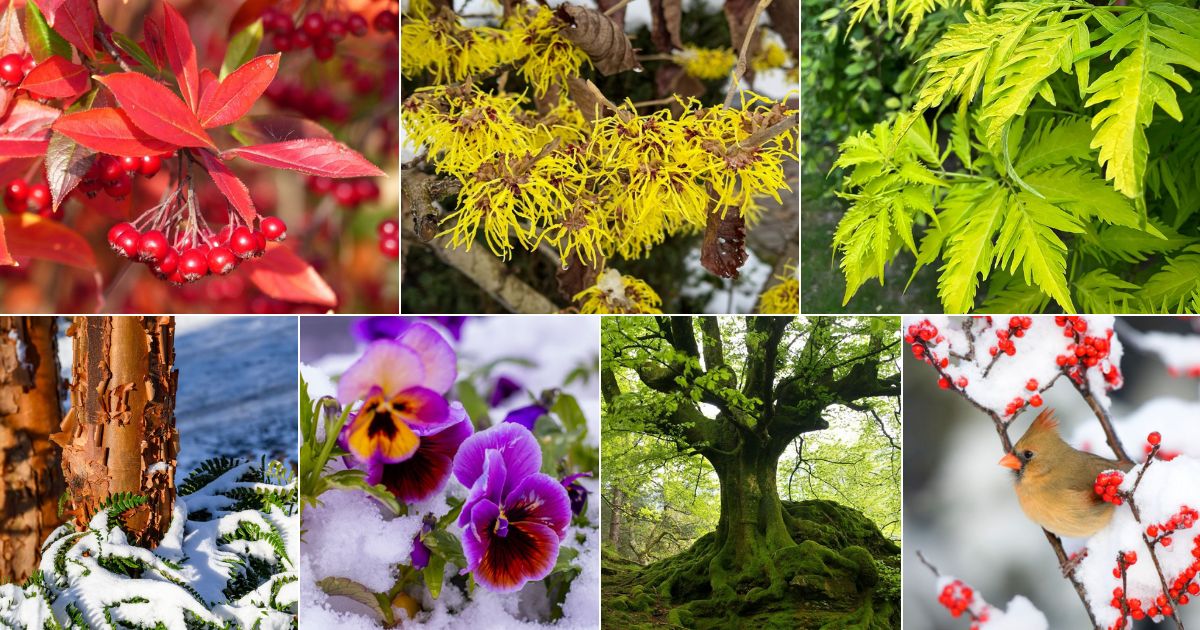
Creating such a garden is a challenge because now you’re looking for plants that have multi-season interests.
Naturally, it’s a good idea to aim to have an amazing spring and summer display when your plants are in their best form. Make sure to have plants that are blooming or fruiting in summer. Mix in annuals to liven things up in summer, but you won’t need as many because other plants in the garden will pick up the slack.
Tips for Choosing All-Season Plants

- Mix a variety of plant types together. Don’t plant only annuals. Make a statement by combining shrubs, vines, bulbs, ornamental grasses, and even small trees.
- Choose plants that have variegated or colorful leaves. All plants have leaves, so instead of growing a bunch of green slackers, put leaves to work for your enjoyment! Add a Japanese maple with maroon leaves as a specimen plant. Use bold-colored evergreens as a backdrop, with bright yellow greens and burgundy.
- Choose plants that provide interest for multiple seasons. Some plants with beautiful flowers can also offer fall color, variegated leaves, a striking form, or winter berries. Punctuate your garden with stands of ornamental grasses that have bright variegated leaves, then sprout plumes that last all winter.
- Pay attention to the other aspects of garden design. As you’re drawing your design and matching plants with complementary colors, find ways to play with the overall composition of the garden. Add plants with interesting and contrasting textures. Find surprising forms, such as a small specimen tree with twisting, gnarled branches. Play with shapes and rhythms, such as a row of little round evergreen shrubs followed by a burst of ornamental grasses.
- These days, breeders are working hard to bring flowers and plants that are pure eye candy, with variegated or colored leaves, long-lived blossoms, and colorful stems or seed pods that add winter interest. So now there are more options than ever to pick from.
- If you’ve underplanted your plants with bulbs in early spring, you can have flowers such as scilla and snowdrops, and crocuses even before the snow cover is gone, before your other plants are even up and blooming.
Your palette is as varied as the kinds of plants you can buy. Read on for good plant selections for each season to try in your year-round garden.
Spring
Spring is the excitement season. This is especially true after you’ve gone through a snowy, blah winter where the whole world is white and brown and gray, and it’s dark when you leave work every night, and all you get is endless gloom and cold outside.
I should add that winter is coming up as I’m writing. I will be constantly wearing a coat for the next six months, and nobody lets you hibernate if you’re not a bear. It’s a darned shame.
There’s not a lot blooming in your garden in early spring, but no fear: you can add some color to get the season started.
Trees

The flowers on witch hazel trees, Hamamelis spp., appear in late winter when you’re wearing 13 layers and shivering in front of the space heater. But at least you can look outside and see the crinkly little yellow witch hazel flowers and say, “Spring’s almost here!” Witch hazel is a low-maintenance, native tree that tops out at 10 to 20 feet.
Witch hazel hybrids bear larger and brighter blooms and also feature fall foliage in bright reds and yellows.
For a pretty late-winter show, plant witch hazel where the afternoon sun will backlight their golden blossoms. For extra color, underplant this tree with hellebores, scilla, snowdrops, and cyclamen (where they’re hardy). Add lilies-of-the-valley (Convallaria) for later in the season.
If you like magnolia trees, try star magnolias, Magnolia stellata, which are hardier than the tulip magnolias (Magnolia x soulangiana). A hard frost will turn the frothy pink blossoms of the tulip magnolia into brown mush, but the star magnolia keeps on blooming, unperturbed.
Magnolias are slow-growing trees, but they keep growing for decades. Slow-growing trees are built slowly and are so much stronger because of that.
Combine your star magnolia with some rhododendrons or azaleas, both spring-blooming shrubs, for extra brilliance.
Shrubs
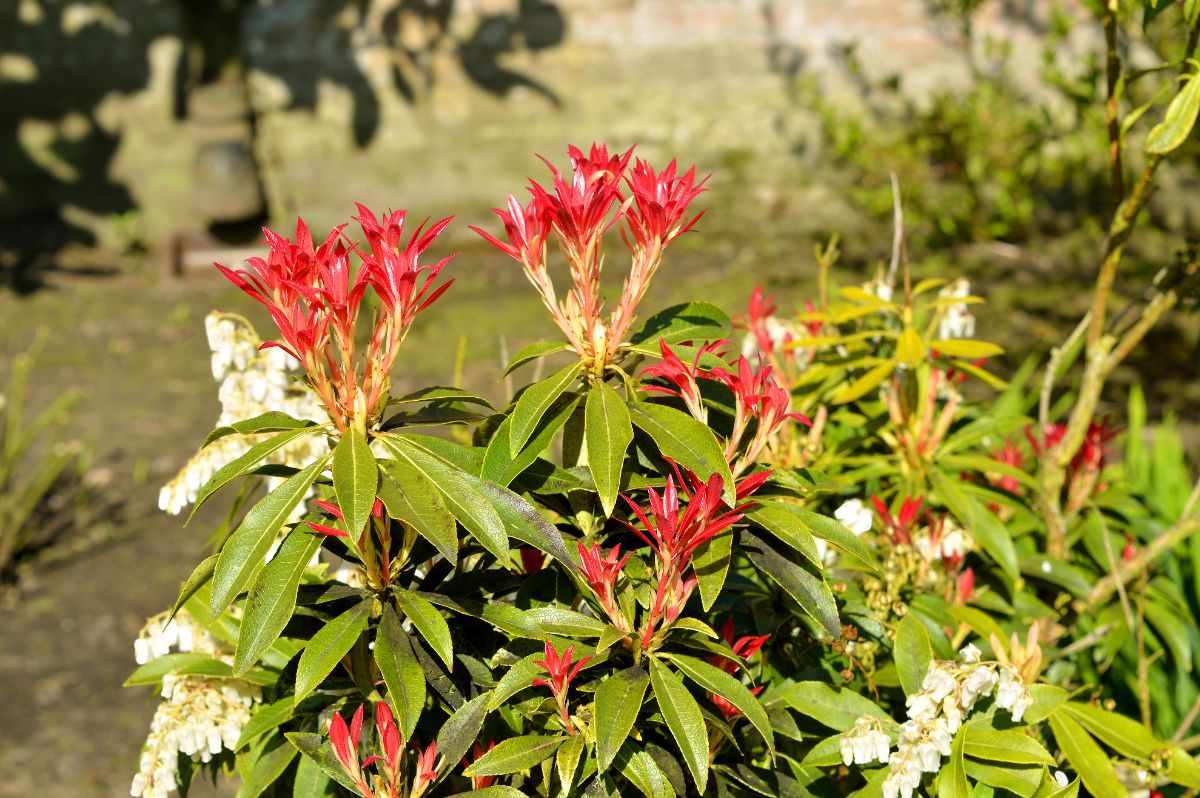
Pieris, also known as andromeda (Pieris formosa var. forrestii), is a shrub I kept meaning to add to various gardens but, for one reason or another, never managed to do. These make an excellent show in spring. The new leaves on this plant come out bright red, fading to pink, then white, then green. The leaves almost look like flowers themselves. It makes for quite a show.
In early spring, pieris bursts into bloom with drooping panicles of fragrant white or pink flowers that look like tiny lanterns. This shrub prefers acidic soil since it’s in the acid-loving Heath family (Ericaceae). Mulch it with a deep layer of peat or pine needles.
Dwarf fothergilla (a.k .a. mountain witch-alder) is a lovely shrub. In early spring, it bears white bottle-brush flowers in profusion, and they have a soft honey scent. In fall, the foliage turns to a lovely yellow brushed with orange-red and sometimes a brilliant orange-red brushed with yellow.
Perennials
Perennials are still one of my favorite components of the garden because you plant them once, and then you’re done for a couple of years. Perennials are generally long-lived plants that don’t require a lot of maintenance – two attributes that rank high in my book!
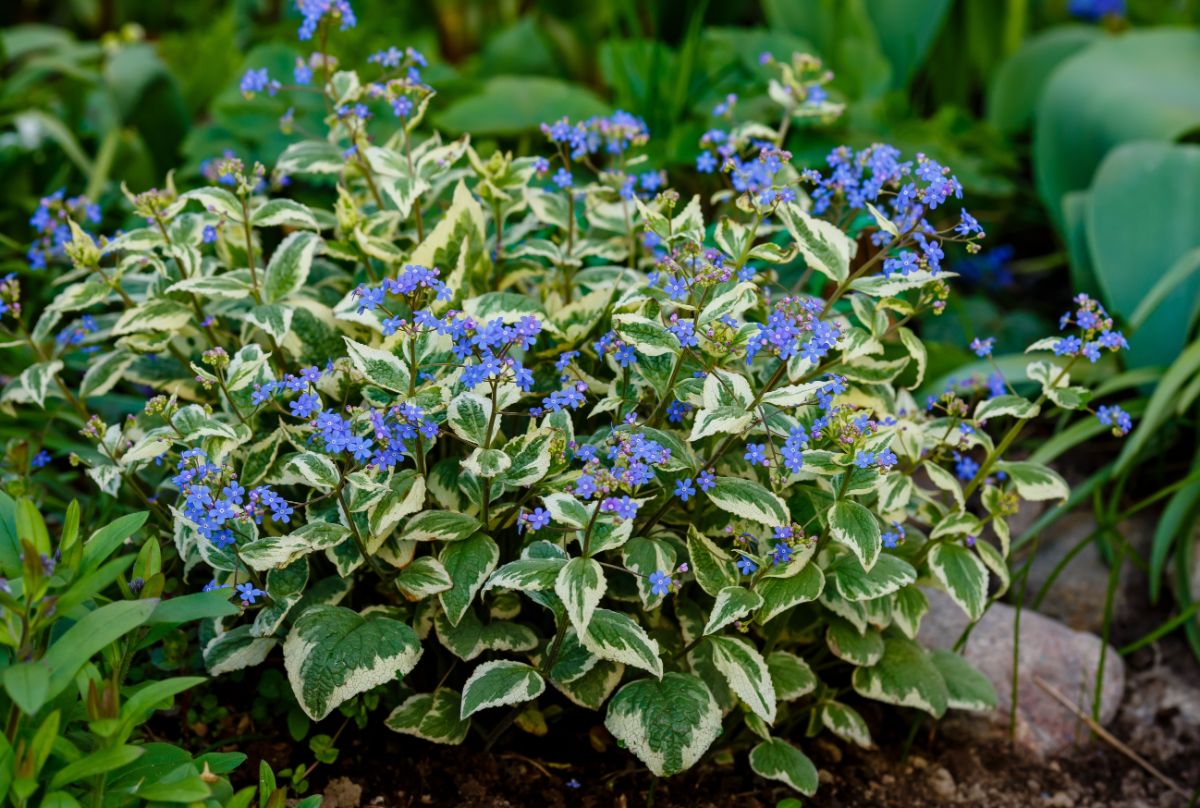
Brunnera macrophylla, which is often called false forget-me-nots or Siberian bugloss, is a shade-loving plant with large, heart-shaped leaves and pretty little blue flowers. This is a good, reliable perennial.
These days, you can find Brunnera varieties with variegated leaves that light up your shade garden for the rest of the season after the blooms have finished. Good choices include Brunnera ‘Sea Heart,’ ‘Variegata,’ ‘Alexander’s Great,’ the old standby ‘Jack Frost,’ and the form with lime-green leaves, ‘Diane’s Gold,’ which can be grown in a sunnier location.
If you plant a forsythia bush, you can grow Pulmonaria ‘Mrs. Moon’ around it to complement its bright yellow flowers. Pulmonaria saccharata, also known as lungwort, is a low-growing perennial that has pretty leaves spotted with white that are attractive throughout the whole growing season.
They bloom at about the same time as forsythia, bearing pink buds that open to sky-blue flowers – a good match with the yellow forsythia blossoms. Lungwort is an old standby in the perennial garden.
A lot of old-fashioned perennials blaze brightly in spring. Leopard’s bane – Doronicum orientale – is a bright yellow daisy that looks great with tulips or other spring bulbs. The foliage might go dormant in summer, so plant hostas or wallflowers around the leopard’s bane so you don’t have a gap in your perennial garden.
Bulbs and corms

To get a jump on spring, plant early-blooming bulbs. Snowdrops and crocuses will pop up through the snow. Siberian squill with its tiny flowers in the most wonderful shade of cerulean. If you plant squills in your yard, they’ll spread all over, and you’ll have lots of spring color. Mix them with grape hyacinths, Muscari, which also spread.
Tulips are one of the classic flowers of spring, and they’re available in many different varieties, species, and forms. You can get the Greigii hybrids, which have reddish-purple lines on the upper leaves and large, cuplike flowers with an eye at the center, or the small Tulipa tarda, which bears clusters of four or five starry flowers.
Some tulips can be planted as long-lived perennials. Others, such as the exquisite ‘Angelique,’ which looks like ruffled pink peonies, will need to be treated as annuals and possibly replaced every year.
Mix daffodils among your perennials. There’s nothing happier than the first bright yellow daffodils popping up and telling you, “Never fear! Spring is here!”
Underplant your early-blooming trees and shrubs with bulbs. Hostas underplanted with spring-blooming bulbs is an especially good combination. When the bulb foliage is dying off, the large hosta leaves grow out and cover the finished bulb foliage. When the bulbs go dormant, the hostas have already taken over the area with their variegated leaves, making it look good.
Summer
Trees
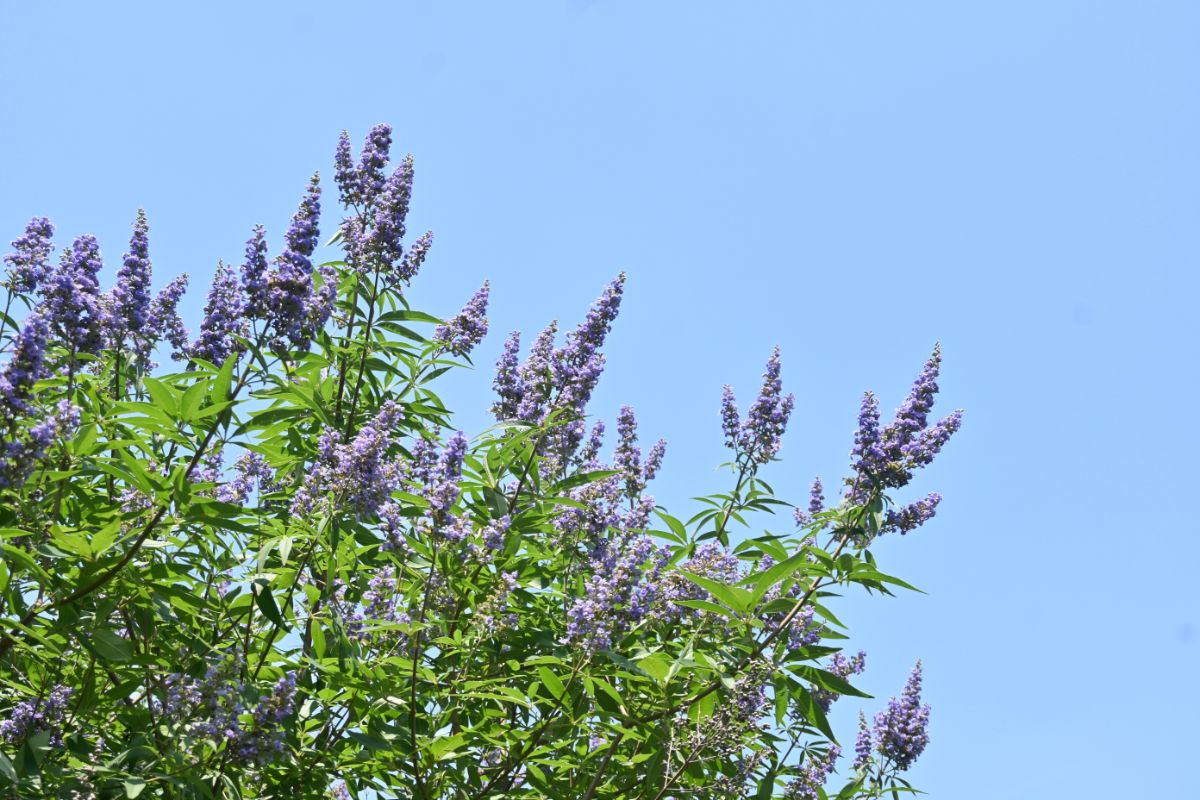
Vitex agnus-castus, known as a chaste tree, was an especially noteworthy tree that is a favorite in Southern gardens. And for good reason: Vitex is a small, multi-stemmed tree with panicles of sweetly scented purple blossoms.
The green-grey foliage, too, is scented. This little tree grows only 10 to 20 feet tall, so it’s easy to tuck it into your yard where you want its fragrance and color.
Vitex doesn’t need much maintenance, though you’ll have to trim offshoots so the tree won’t turn into a shrub. (Of course, if you are so inclined, you can certainly let it go shrubby.)
Goldenrain trees – Koelreutaria spp. – are a coarse-branched medium-sized tree, growing to 20 to 35 feet tall. In summer, they bear large panicles of golden yellow flowers, which are then followed by pinkish paper lanterns that later turn brown and stay on the tree until late in the year. Goldenrain trees bear deeply cut pinnate leaves that are very handsome.
Redbuds (Cercis spp.) are known for their spring flowers, small purplish-pink buds that appear in April as heralds of spring. But now redbuds also add summer and fall color with their leaves. ‘Forest Pansy’ as well as ‘Merlot’ are redbud varieties that sport maroon or burgundy leaves after the redbud flowers go to seed. ‘Rising Sun’ sprouts new leaves in a bright yellow that eventually fades to green.
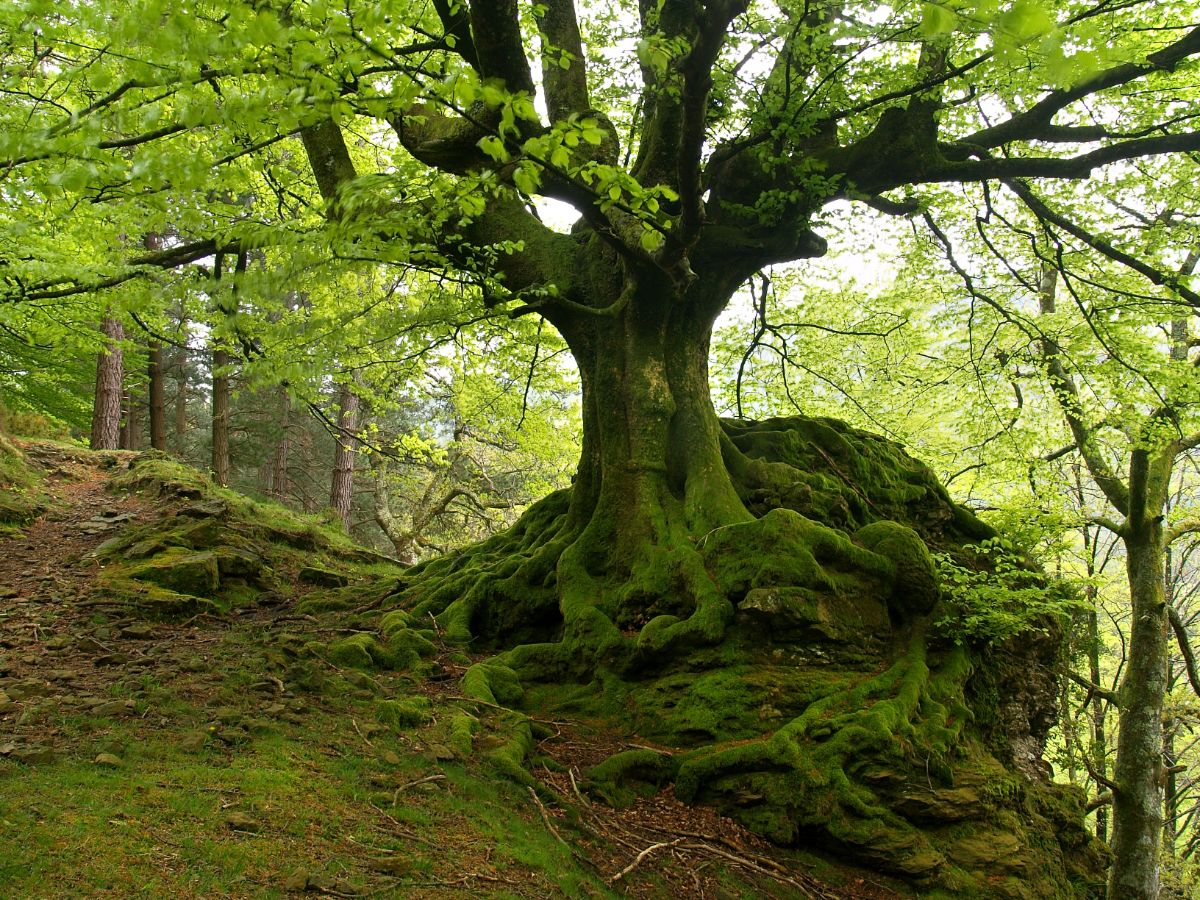
Every time I see a European beech (Fagus sylvatica), I want to dig it up and take it home (an impossibility) because these trees are so graceful and stately.
Beeches sport a smooth, grey trunk, and many beeches also have burgundy foliage, such as ‘Dawyck Purple’ and ‘Red Obelisk.’ ‘Riversii’ is a selection that has purple leaves in the spring that turn copper in the fall.
You can also plant a tricolor beech, with purple leaves bordered with rose and white. If you are looking for a good tree to provide a striking form in the year-round garden, many weeping beech varieties are available.
Beeches seem to prefer the cooler temperatures of the north. Here in Missouri, the leaves of the variegated varieties tend to scorch in our hot temperatures. Variegated beeches do better in hot locations if they have some dappled shade during the summer.
Shrubs
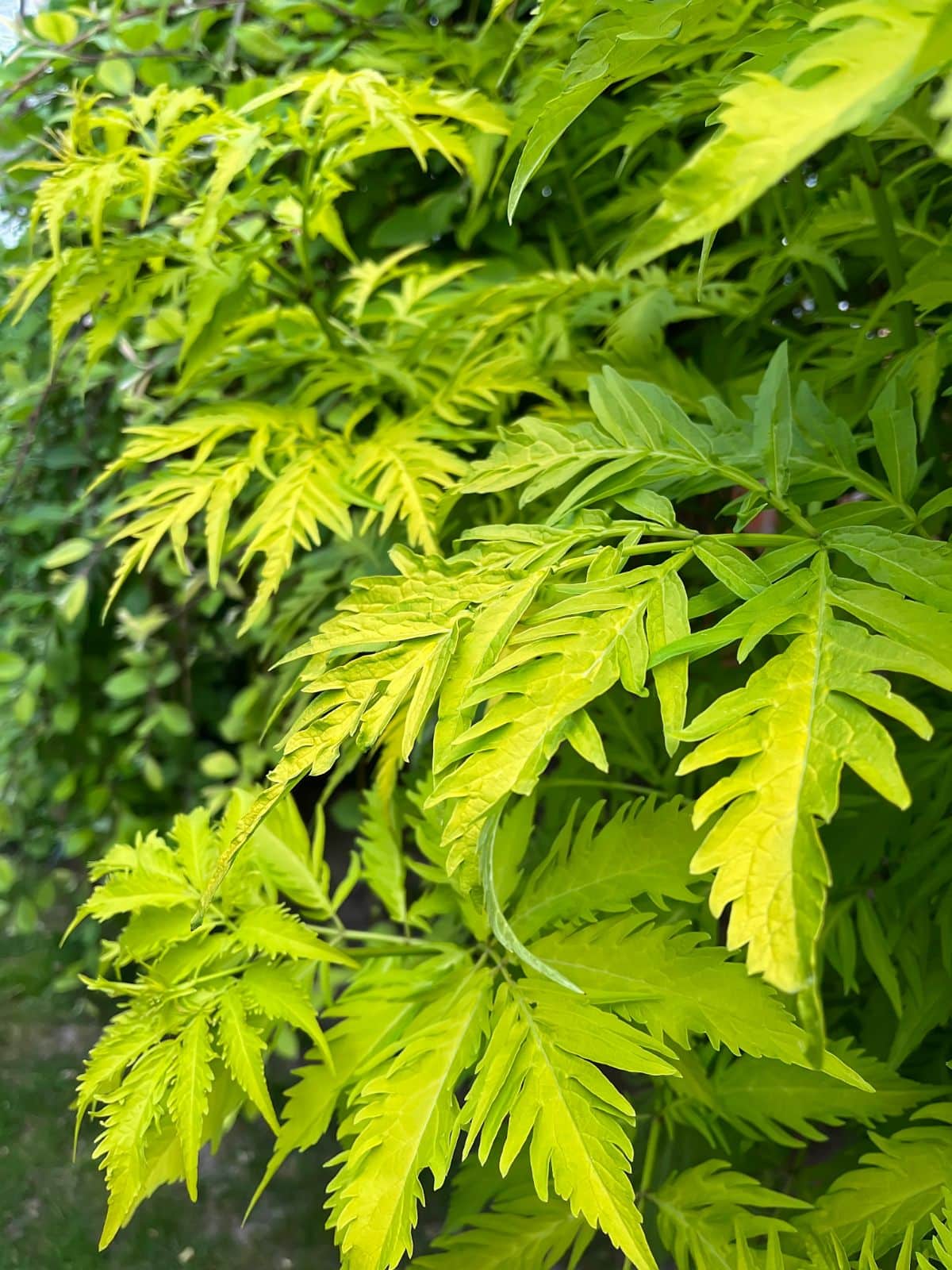
In the wild, elderberries (Sambucus nigra) are good shrubs for birds and for the year-round garden. In summer, they bear large platters of tiny white flowers, followed by small purple-black berries that are edible for birds and people alike (though quite seedy).
I pick the berry clusters and put them in the chicken yard as treats for my hens. However, wild elderberries also spread like crazy via seeds and suckers and are often scraggly.
Now you can get elderberry varieties that have gorgeous, wine-red leaves and a tidy habit. Sambucus ‘Black Lace’ has ferny, dark purple leaves.
Sambucus racemosa ‘Sutherland’s Gold’ has yellow-green leaves that remind me of sumac leaves. It can be grown as a small tree, and it bears small clusters of red berries. This is the English elder tree.
Sweetspire (Itea virginica) bears white, sweet-scented, six-inch flower spikes in summer, followed by red-purple foliage in fall. Varieties commonly available include ‘Henry’s Garnet,’ with purple, red, and yellow leaves in fall and larger flowers than the original species. ‘Merlot’ is a dwarf sweetspire variety with striking wine-red fall color.
I will acknowledge that barberries – Berberis varieties – are great all-season shrubs. They sport tiny yellow flowers in spring. Their fine-leaved foliage comes in all kinds of shades – some have rich, wine-red leaves, while others are a jaunty lime green that looks great all summer. In fall, barberries have cute little red berries that last all winter.
So barberries have very good points. The only problem is that barberries also have very sharp points. I’ve trimmed many barberry hedges in my horticultural career, and their thorns are very slim, and there’s no nub at the base of the thorn to grasp to pull the thorns out of my fingers. Even when you wear leather gloves, those thorns will poke through the seams of the gloves and jab you.
Perennials
Ornamental grasses are good candidates for the all-season garden. They provide form, long-lasting color, and winter interest while being hardy and carefree.
Hakonechola is one example of an ornamental grass that really fits the bill. It’s a lovely grass from Japan, where its beauty is greatly prized. It’s a low, mounded grass, variegated yellow and green in spring and summer. In fall, it produces feathery flower plumes that look beautiful in winter.
Yarrow – Achillea tomentosa – bears large plates of golden yellow flowers in midsummer. Their feathery leaves have a silvery-grey hue that is lovely when it’s not blooming.
Yarrows come in all shades and colors. Paprika yarrow (A. millefolium ‘Paprika’) has paprika-colored flowers and fine, ferny leaves. Yarrows overall perform well even during hot, dry summers. You can leave the flower heads up after their blossoms are done to add interest to your winter garden.
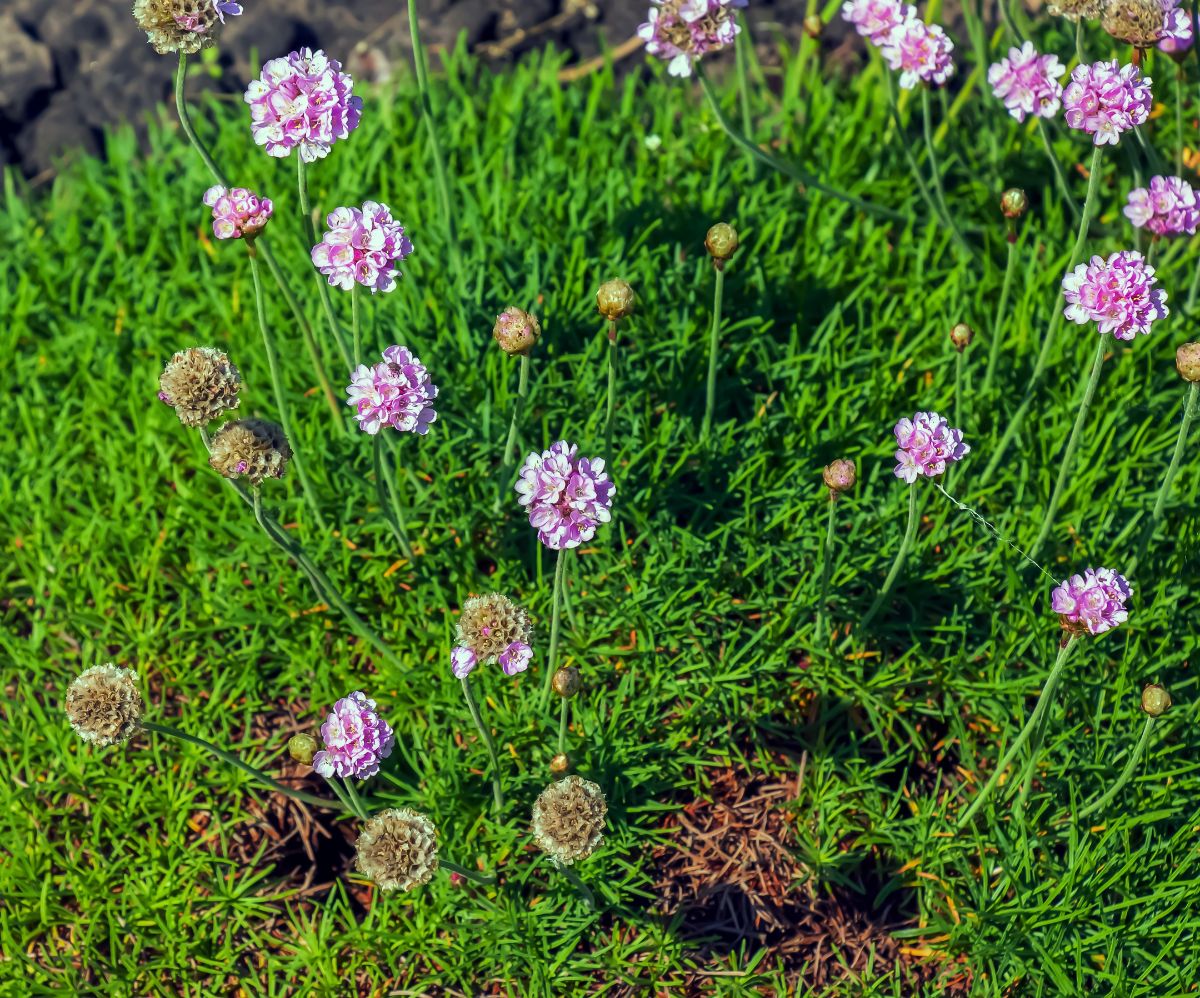
Sea thrift, Armeria, is an old favorite of mine. It’s a small, low-growing plant that looks like a tuffet of very tidy grass. But in early summer, the little plant sends up round clusters of dark pink flowers.
It’s native to the shores of Britain, where it clings to the rocky cliffs above the sea and blooms like crazy. So they’re also tough little plants. A sure winner.
If you have a paved path in a carefree garden, then you should have thyme – specifically, Thymus praecox arcticus.
It’s a tough little thyme that makes a low, dark green mat on the ground, which in early summer turns into a low, purple-red mat on the ground. Let it grow up in your walking path for color, and enjoy the scent of thyme that rises up when you walk on it.
Fall
Trees
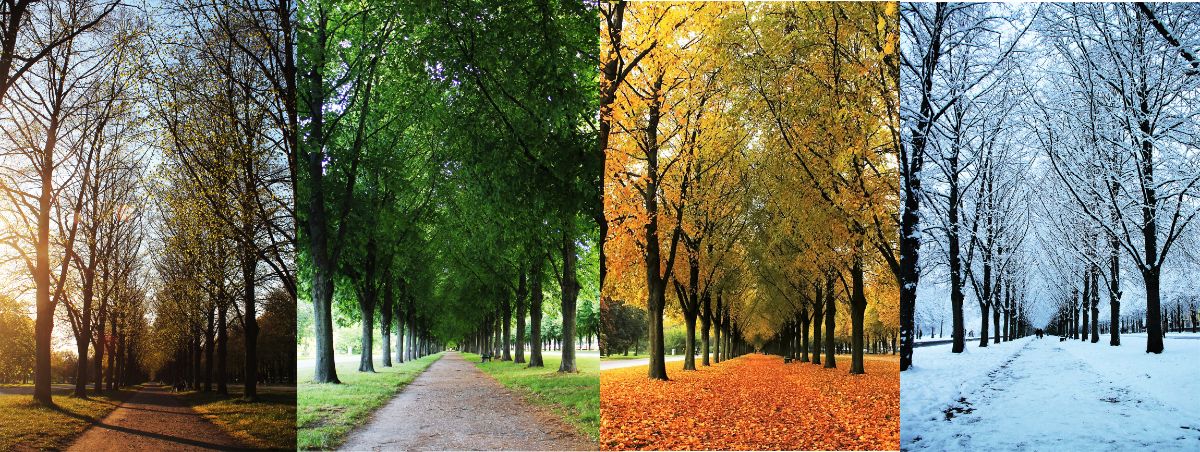
Many deciduous trees truly shine in fall. Sugar maples, ginkgos, sumac, and sweet gum trees all deck themselves in gorgeous colors. What’s more, all of these trees have new hybrids and selections on the market that are bred for intense, reliable color.
Black gum, or tupelo, Nyssa sylvatica, is one such tree. Tupelo is a very slow-growing tree, but its leaves turn a most amazing hue of scarlet in autumn.
Japanese birch (Betula platyphylla ‘Whitespire’) has white, peeling bark, which is a handsome addition to the garden all year round, and in fall, these birches make a lovely show of brilliant gold leaves.
In some parts of the United States, the bronze birch borer has been a real problem for birches, but the ‘Whitespire’ birch is more resistant to the beetle than the hapless B. pendula, which the borers treat as their personal buffet.
The Whitespire birch is not wholly resistant, as stressed trees can find themselves plagued by borers. Plant your birch in a place with deep soil, like a backyard. Avoid planting them in the hellstrip between the street and the sidewalk.
Give your birches (or indeed any tree) a place to stretch their roots out and a nice layer of mulch in a ring around the tree that does not touch the trunk.
The perpetual favorite fall foliage tree is the sugar maple (Acer saccharum), with its yellow, orange, and red leaves that brighten many a street and backyard in fall. Red maples (Acer rubrum) turn a brilliant red all over.
Shrubs
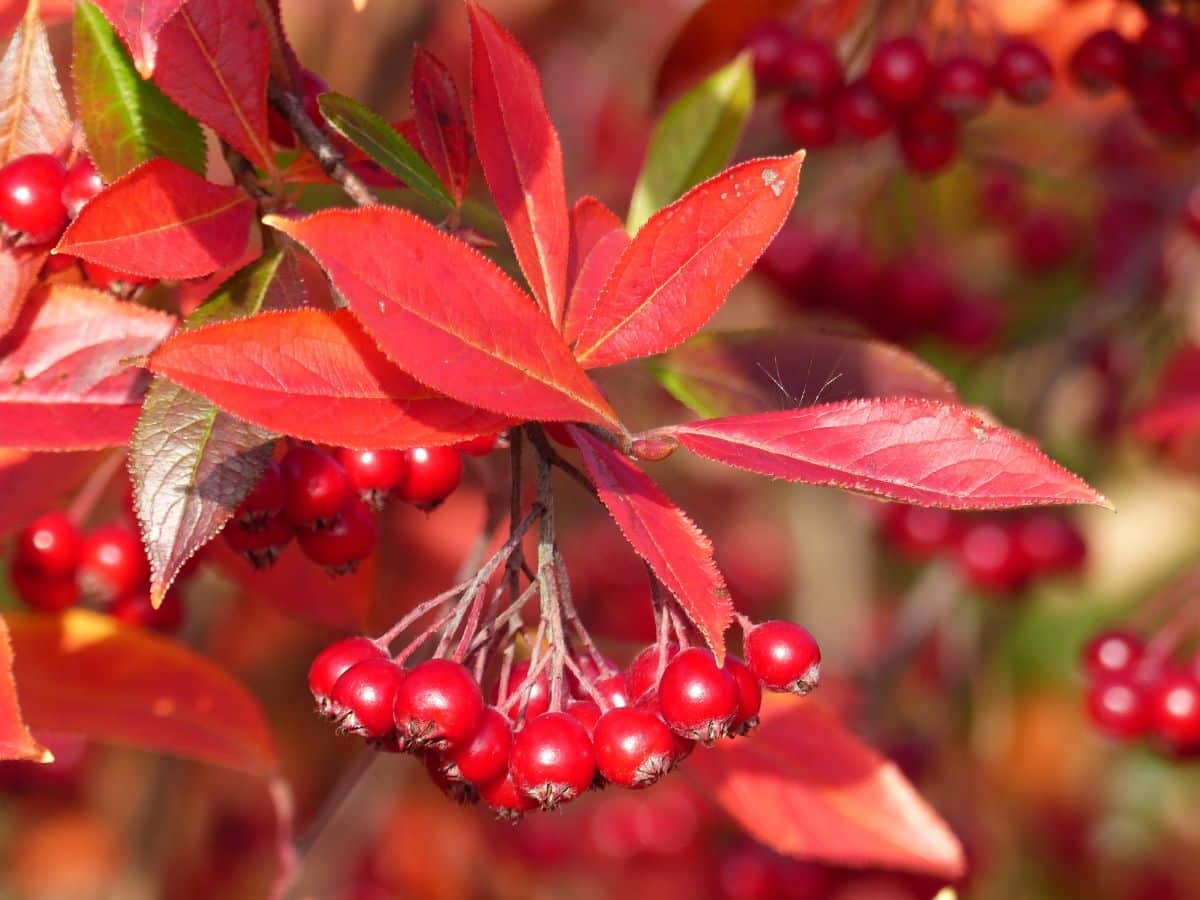
Chokeberry, Aronia arbutifolia, bears fragrant white to light-pink flowers in spring. In fall, chokeberry trees bear a generous portion of brilliant red berries that last through the winter (and you can make jam or jelly with them). When you add in its epic, brilliant red fall color, chokecherry makes a great year-round shrub.
This shrub can spread to some extent, but it’s a great low-maintenance plant and looks good in naturalized masses in borders or natural settings. It is a member of the rose family, which is why its spring flowers resemble apple blossoms.
Serviceberry, Amelanchier canadensis, is another member of the rose family that sports white blossoms in spring, red foliage in fall, and berries in summer through winter, though these are usually eaten by robins before they make it to winter. Serviceberries can be grown as a shrub or small tree.
The species can be naturalized and does well in wild areas, but if you would like a small serviceberry tree in your yard, go with one of the new varieties that are bred for show. You can get Amelanchier laevis varieties such as 'Cumulus', 'Prince Charles' and 'R.J. Hilton' if you’d like a lovely tree with a columnar shape. Amelanchier x grandiflora ‘Autumn Brilliance’ offers intense orange-red color in fall.
Perennials
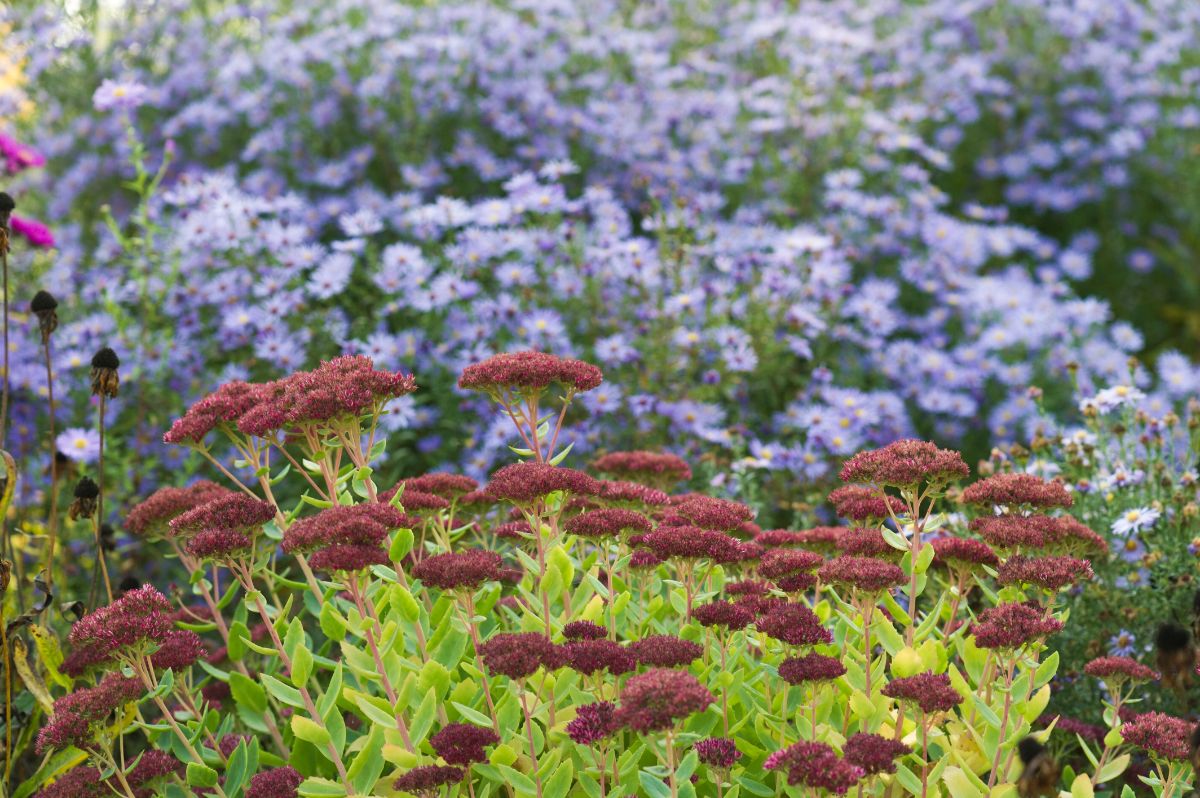
Asters are an old favorite, though in some areas, they can be an invasive species. But they come in so many different sizes, shapes, and colors that you can create a huge drift of them by sitting tall asters in the back down to dwarf aster varieties in the front. Asters are carefree and don’t need much care and really can put on a show of color.
Another fall favorite is Sedum ‘Autumn Joy.’ It bears large pink flower heads, which attract all kinds of butterflies, small wasps, honeybees, and other interesting insect varieties.
Sedums, commonly known as stonecrop, are a diverse species with large plants like ‘Autumn Joy’ as well as all kinds of groundcover-sized varieties with all different leaf colors, and they flower like crazy in season. Whatever form your sedum is in, it’s a cheerful little plant, easy to care for, and it doesn’t fight with its neighbors. A winner all around.
Bulbs and corms
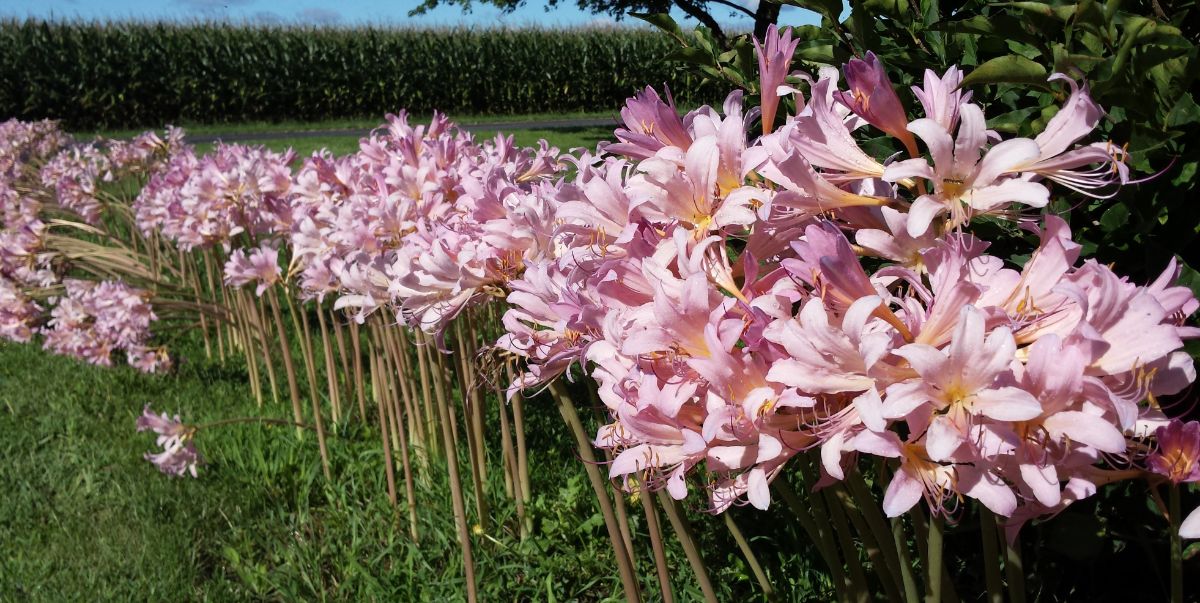
Don’t forget to underplant your shrubs with fall-blooming bulbs such as the ever-popular surprise lily.
I will never in my life forget the time that I saw some pink flowers on long stalks blooming in Grandma Ann’s yard when I was ten years old.
“What kind of flowers are those?” I asked.
“Naked ladies,” Grandma said.
And then I completely died of embarrassment.
Naked ladies are also called surprise lilies because when your church-going grandma says the word “naked” in front of you, you are sure as hell going to be surprised.
Their scientific name is Lycoris squamigera, and the pink trumpetlike flowers stand at the top of a long stem. After the flowers are done, they’ll grow out a bunch of long, straplike leaves for the rest of the year. You can put surprise lilies in the middle of a bunch of hostas or ground cover and let them pop up and make a nice impression on everyone.
And if some kid asks you what those pretty flowers are, tell her they’re surprise lilies. She’ll thank you later.
Winter
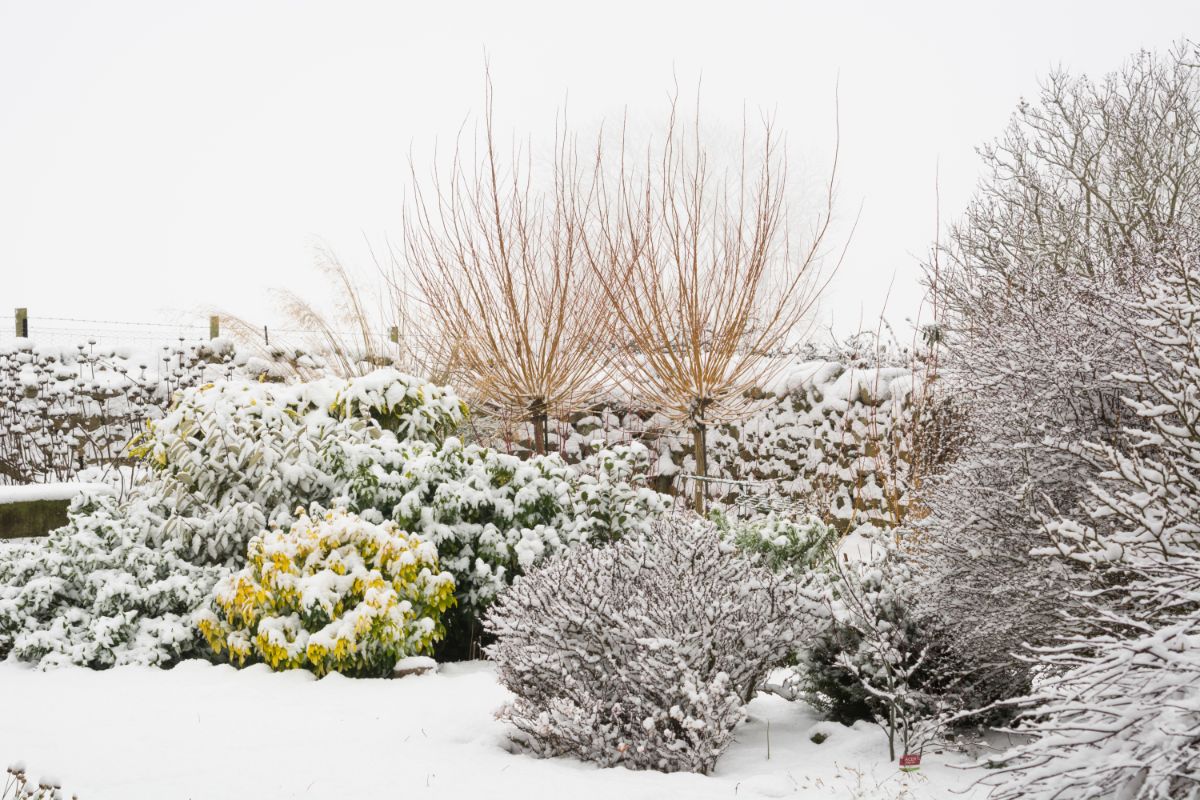
Winter doesn’t have to be bleak and colorless in your garden. This is the hardest season to plant for … until you look around at all the amazing new plants being rolled into commerce.
Breeders have been working hard to select new varieties that are pure eye candy, even in the coldest and darkest time of the year. These colorful plants will shine through the snow even on the gloomiest days.
Side note: Winter is when your garden design will be pared down to the bare bones. This is a good time to review how your design looks and think of ways to improve it.
Trees
Specimens with exfoliating bark are a good choice for year-round beauty, but they make an especially good show in winter. River birch (Betula nigra) is a great, multi-stemmed tree with buff-colored peeling bark. It’s a good shade tree through summer and has plenty of winter interest. Also, it’s resistant to borers, which paper birch trees (including European white birch, Betula papyrifera) tend to be susceptible to.

For small spaces, a paperbark maple, Acer griseum, is a lovely choice. These are small maple with textured, exfoliating bark in several different colors of gleaming bronze.
What’s more, the branches are twisty and craggy as an old oak's, like sculpture. Paperbark maples also bear the bright red and orange leaves in fall as other maples do – a win-win. I’m always enchanted by these little trees.
I like ginkgos in winter because of the almost architectural form of their branches. Ginkgos are very slow-growing trees, so the potted trees are more expensive because. If you can invest in one and have the space to grow one of these vast trees, do it. They’ll reward you for a hundred years or even more.
Holly (Ilex aquifolium) is a good tree – unless you live on the West Coast, where it has become a noxious, invasive weed. In other climates, you have a smorgasbord of hollies to choose from.
Sizes range from a six-inch tall spreading dwarf to a 70-foot tall behemoth. The sky is the limit with these plants – literally.
Remember: hollies are dioecious. If you want good berry production on your female hollies, you’ll need to plant a male plant within 30 to 40 feet of them.
Shrubs

In winter, evergreens will steal the show.
Evergreen shrubs throughout the garden will add colors to your garden even when snow is thick on the ground. Plant some little boxwoods, trimmed into balls, through the garden to keep the design lively.
Many evergreen conifers now have yellow branches, such as ‘Ember Waves’ western arborvitae, ‘Golden Globe’ arborvitae, ‘Sea of Gold’ juniper. ‘Carstens’ Wintergold’ mugo pine is a breathtaking shade of fiery orange that I’ve never seen before in a conifer. In winter
Variegated winter daphnes add green and yellow to the landscape year-round and bear flowers with romantic fragrance in late winter and early spring.
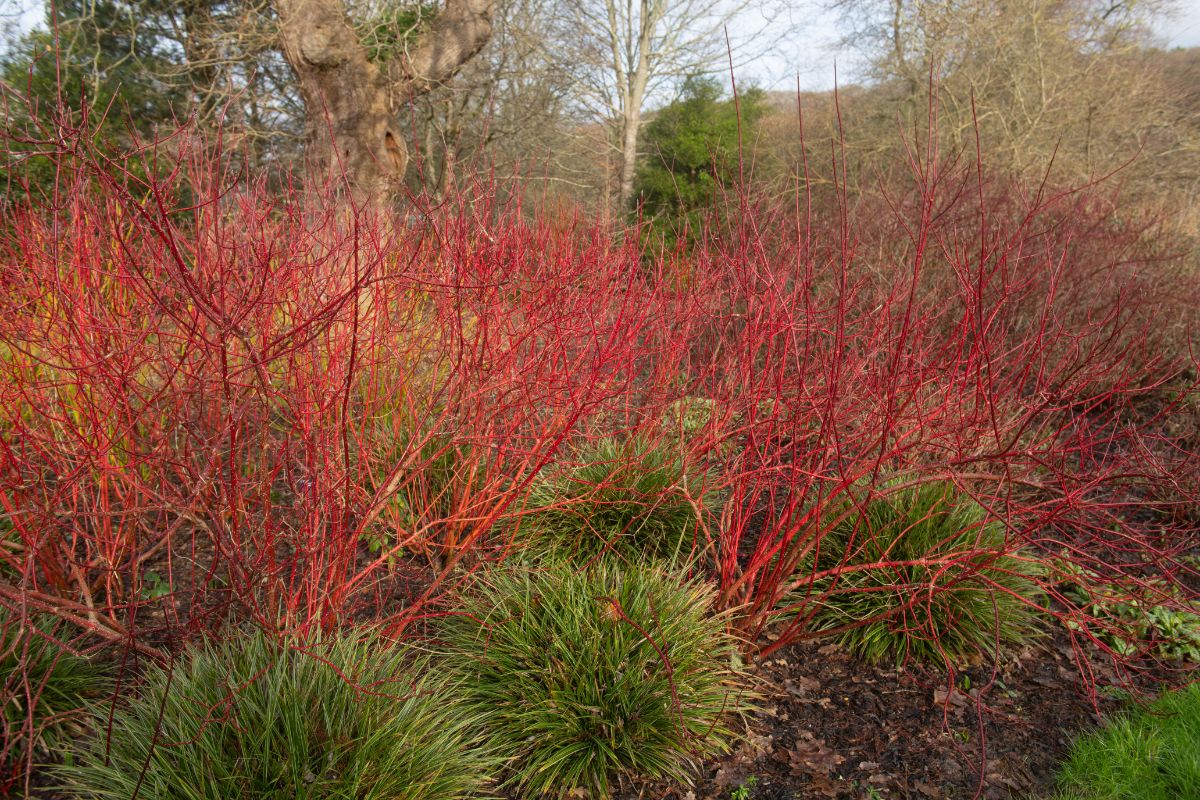
For winter interest, choose shrubs with interesting bark or colorful twigs (as with the red-twig dogwoods) and berries.
Bonus points: Plant several different types of shrubs with berries so birds will have a lot of good food – and birds will bring their own splash of color and life to your winter garden. Give them some thick conifers to hide in, along with a source of fresh water when it’s below freezing.
Viburnums are good shrubs for colorful winter berries, spring flowers, and fall color. European cranberrybush, Viburnum opulus, bears bright red berries that turn into dried red raisins, while the American version, Viburnum trilobum, bears large clusters of red berries. You can eat the fruit from the shrub or use it to make preserves.
Ornamental grasses
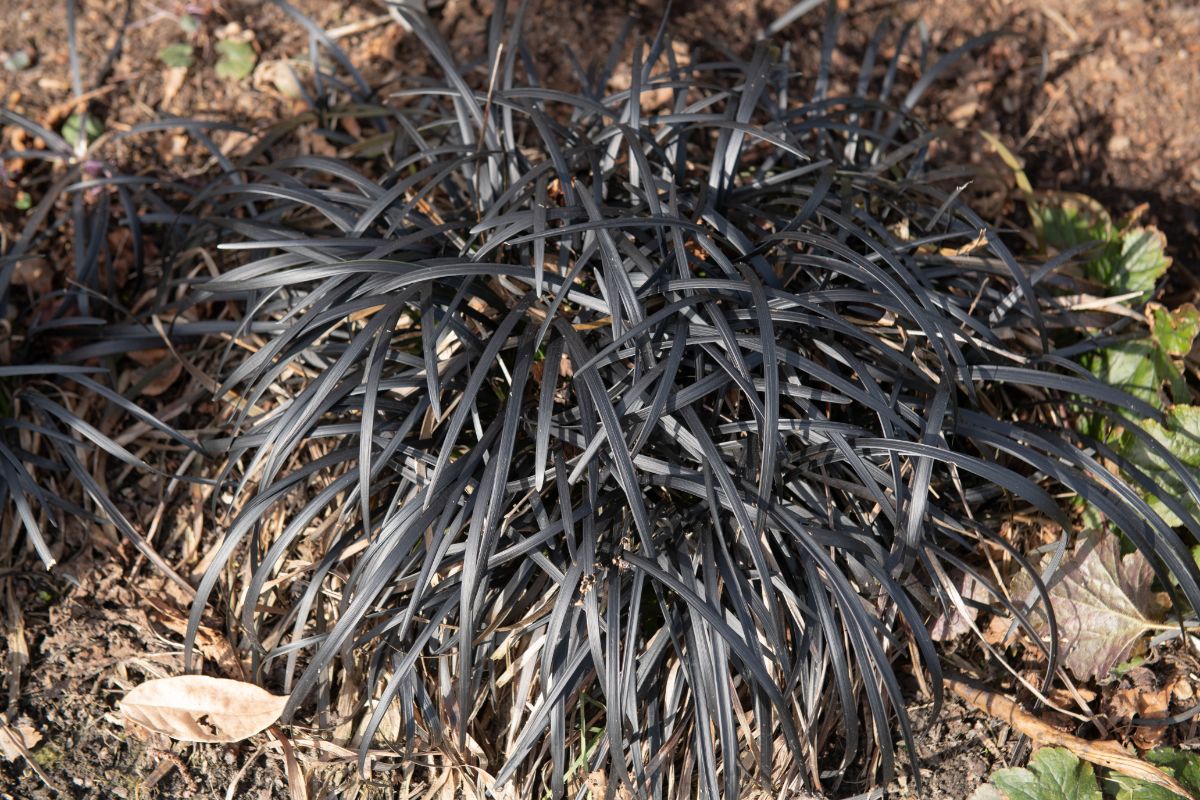
Add ornamental grasses to your winter garden. These come in all kinds of different forms and shapes. Hakonechloa, also known as Japanese forestgrass, is a yellow and green weeping grass. Blue fescue is small and spiky and bluish and cute. Pennisetum is about two or three feet tall with wine-red leaves and soft red foxtails.
You don’t have to trim back your ornamental grasses in fall – keep them to provide winter interest in your garden.
Flowers in winter?! Sure!
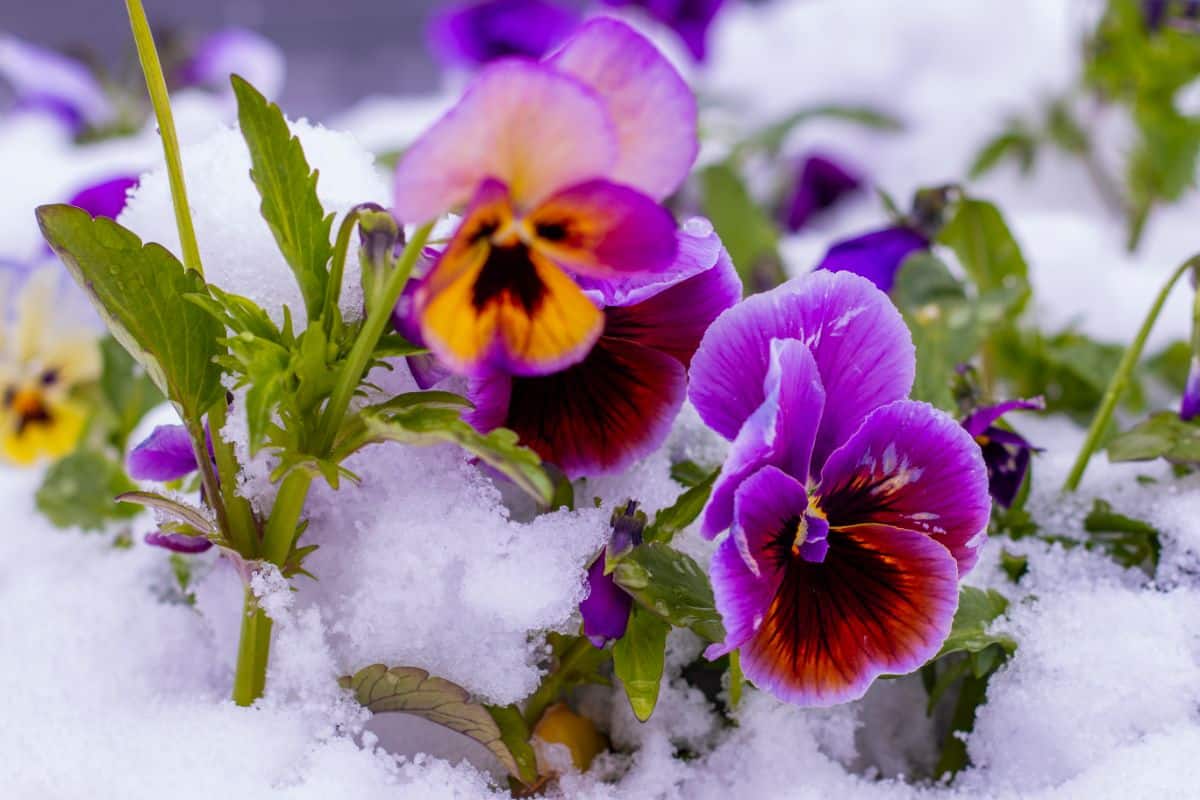
In late fall, you can plant some cold-loving flowers and plants to carry your landscape into winter. Pansies are the ultimate warriors when the temperature drops and will keep smiling even as the snow falls on them.
Ornamental kale is also cold-hardy and will brighten a landscape through November and even December, depending on the weather.
Snapdragons stop blooming reliably somewhere in October, though their foliage will stay green through November.
Growing a four-season garden requires some forethought and planning and a willingness to try different plants in the garden, but the results are worth it.

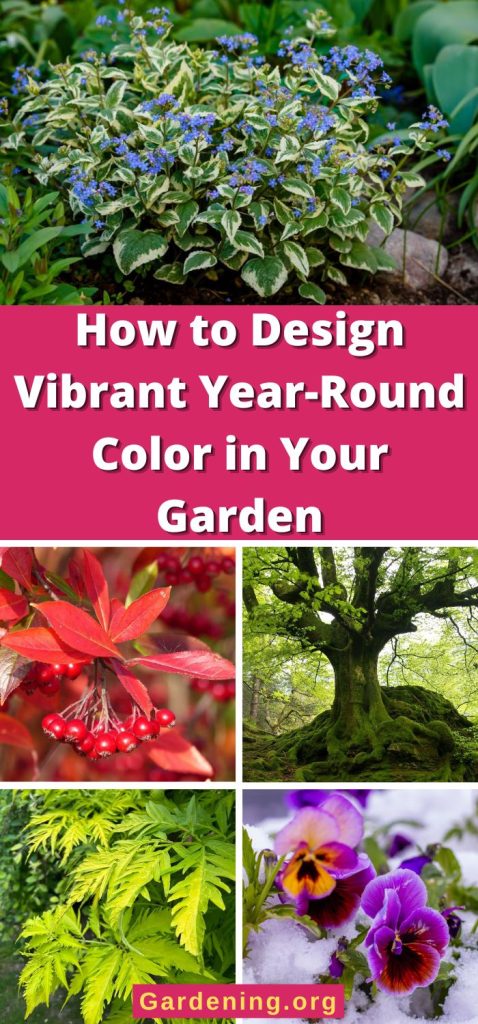
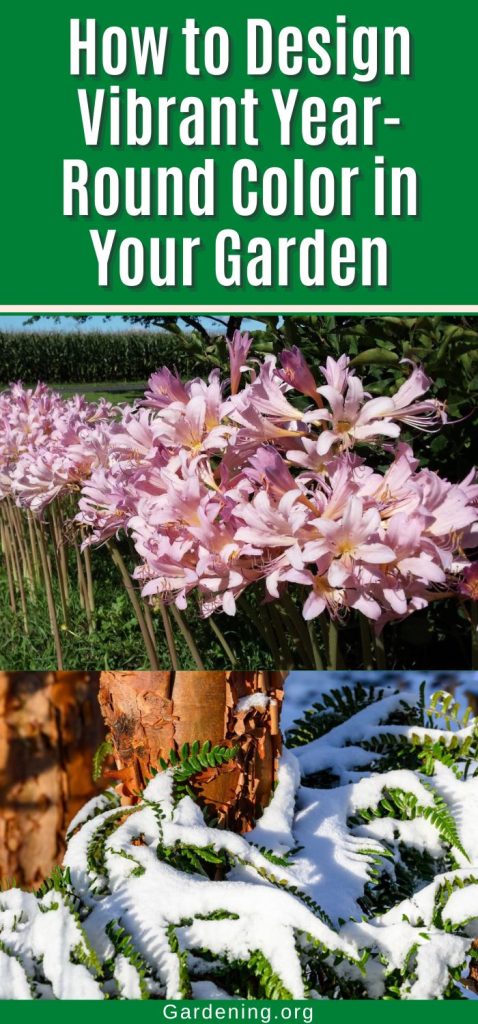
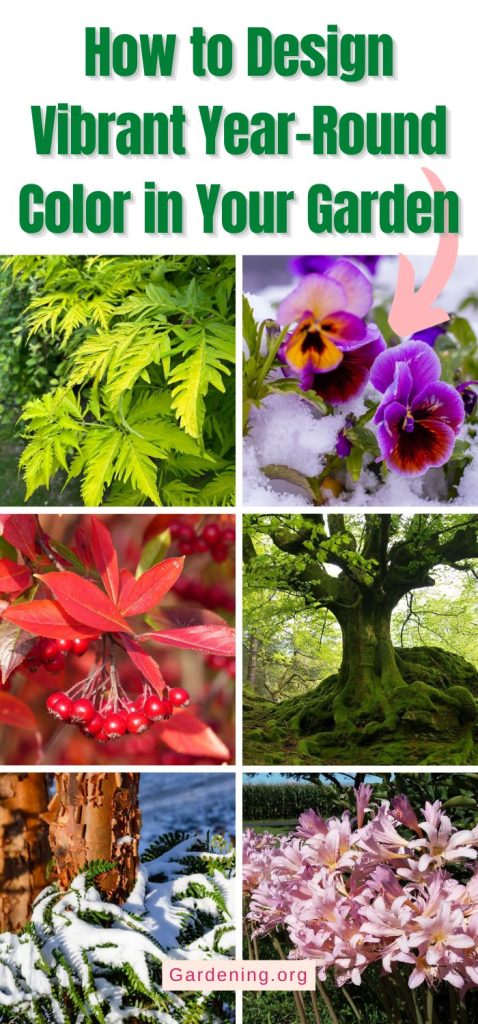
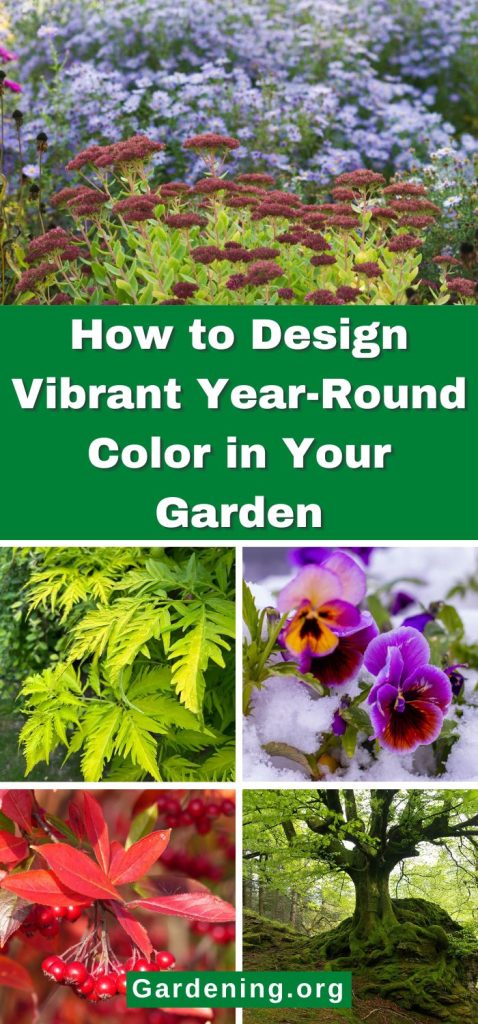
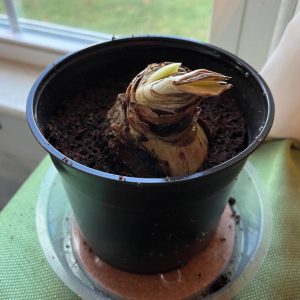



Leave a Reply